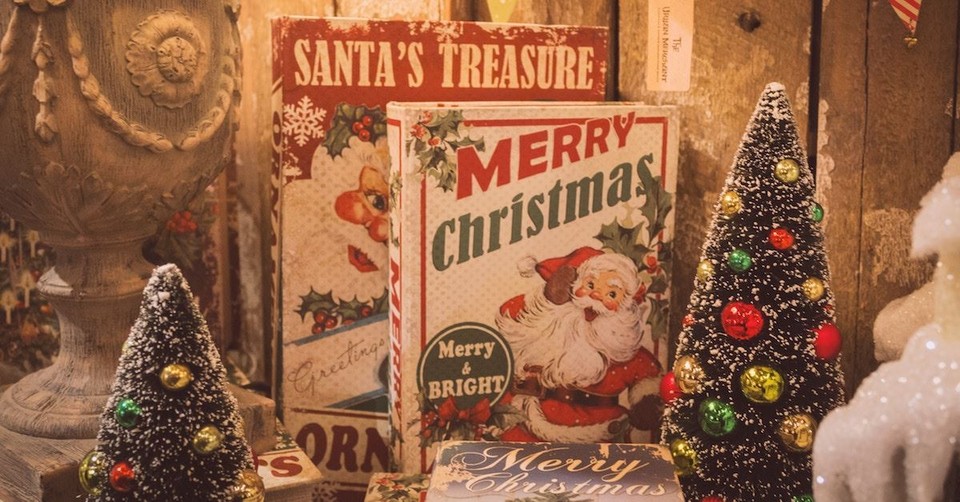3 Reasons St. Nicholas Would Not Have Wanted to Be Santa

Most of us equate Santa Claus with St. Nicholas, and with good reason. “The Night Before Christmas” poem describes the personality, outfit, and actions of Santa Claus but refers to him as “St. Nick.” That means they’re the same person, right?
St. Nicholas of Myra and Santa Claus of the North Pole are separated from each other by hundreds of years of history and culture, not to mention that one is a legend while the other is legendary, one the creation of cultural imagination and the other a matter of historical record.
And while we cannot know for certain, we can well imagine that St. Nicholas would turn down the job of Santa Claus. Obvious humorous drawbacks include reindeer care, small children yanking on your beard, workshop labor disputes with elves, claustrophobic anxiety resulting from crawling down chimneys, weight and health issues that accompany a diet of cookies and milk, and, of course, the pressure of being perpetually jolly. But most importantly Christ was the center of St. Nicholas’ good deeds.
Here are three reasons St. Nicholas would not have wanted the role of Santa, with fun, historical facts mixed in:

1. Living in the North Pole would not have been ideal.
The striking beauty of the North Pole must be balanced against some obvious drawbacks: the constant cold, lack of seasonal diversity, absence of natural greenery, and general inaccessibility of outdoor activities like swimming, barbequing on the lawn, and getting a tan. It is hard to imagine that Nicholas, who lived his entire life on the sunny coast of the Mediterranean Sea where the average daytime temperature is 75°F, would trade his home for the frozen north where temperatures hover at 32°F in the summer and -40°F in the winter.
How did the North Pole become home to Santa Claus? In the mid-1800s, America, and especially the city of New York, became fascinated with the Arctic regions. Readers devoured tales of howling dogs harnessed to bobsleds and driven by fur-bundled explorers losing toes and fingers to frostbite. In 1825, John Franklin started out from New York for expeditions north. He and his men disappeared in 1845 and never returned. In 1831, James Clark Ross located the magnetic North Pole and, after many failed attempts, Robert Peary planted the stars and stripes at the North Pole in 1909.
The North Pole captivated the public’s imagination with its shimmering landscapes of blueish white set under the ghostly glow of the Aurora Borealis and stretched across unimaginable distances. If ever a home existed on earth for such a magical and mysterious character as Santa Claus, surely the North Pole was it. Nineteenth-century children addressed letters to Santa Claus at the North Pole, and artists like Thomas Nast illustrated his home and environs as early as 1866. The northern-most state capitalized on the appeal and took the name for one of its towns, North Pole, Alaska.

2. Nicholas of Myra would not have wanted to be an icon.
St. Nicholas of Myra did not wear and would not have wanted to wear the standard American Santa Claus outfit. For one, it would have been too hot. While Turkish coastal temperatures can dip in the winter to the low 50s°F, the Santa suit is tailored for a colder environment.
More importantly, the Santa suit contains no Christian symbolism and St. Nicholas was first and foremost a pastor of the Christian church at Myra. Some might point to the European design, the Dutch Sinterklaas for example, who carries a crozier staff and wears the ring, cope, cassock, and miter hat of the bishop, and sometimes even wears a cross or crucifix on a gold chain. While the look is certainly more “Christian” than the American version, it is no more historic or authentic.
St. Nicholas of Myra lived between the years 260-343 (approximately), long before the attire of priests and bishops became standardized. Nicholas would not have had access to conspicuous liturgical regalia because such items did not yet exist. Indeed, throughout much of his life, Christianity was an illegal, minority religion. He would have worn the simple outfits of his fellow citizens – probably gray, brown, or black tunics and cloaks, and perhaps a cross or some symbol of the faith.
The contemporary costuming of the American Santa Claus assumed its permanent form a little more than a hundred years ago. As America transitioned from Nicholas to Santa, illustrators like Thomas Nast (1840-1902) began to toy with a new look – large beard and belly, elfish appearance, fur-trimmed coat and boats. Even so, the forces of commerce were most responsible for standardizing the Santa appearance. By the early 1900s, advertisements, playing cards, toys, and magazines displayed the red suit uniform, black belt and boots, portly belly and large white beard.
Perhaps no one harnessed the marking power of Santa Claus more effectively than Haddon Sundblom (1899-1976). Hired in 1931 by the Coca-Cola Co., he painted warm scenes of Santa with Coke in hand over the next thirty years and in so doing he concretized the look and attire of the American Santa Claus in iconic fashion. St. Nicholas would have never traded his position among the people — spreading the gospel — for shiny red fashion and mass-marketed commercialism.

3. St. Nicholas wouldn’t have wanted to commercialize Christmas.
Every December, Santa receives long lines of small children posing for a picture and relaying their gift wishes. Others mail letters, send emails or tell their parents to pass along the information – all of which must add up to massive databases of gift requests. The illustrators Thomas Nast and Norman Rockwell depicted Santa sitting at his wooden desk and going over long, scrolling sheets of hand-printed lists, but these days he might use a laptop or iPad.
In early modern and medieval times, the children did not submit wish-lists of gift-ideas but instead hoped above all else that their own names would not be found on the naughty list. With good behavior and luck, they would not to receive a lump of coal or a switch but find nuts, oranges, a small doll or toy, and a chocolate coin in their stockings – token gifts by contemporary standards. Just before the turn of the twentieth century, retailers discovered the consumer appetite for children’s toys and gifts and the marketing potential of Santa Claus.
Nicholas secured his place in history by the simple act of delivering gifts under cover of darkness. As a young man, he used his inheritance funds to aid a family in need. A wealthy man in town had lost everything and was considering selling off his daughters into prostitution and servitude. Nicholas intervened, tossing a bag of gold through an open window late one night. The family found the money in the morning and used it as dowry so that one of the girls might marry out of her desperate condition. Nicholas returned two more times with two more anonymous gifts for the other daughters.
The difference between the gifts of St. Nicholas and those of Santa is that Nicholas gave to families in dire need and not for the sole delight of children getting what they want. There’s nothing wrong with family traditions of gift-giving and there’s nothing wrong with the child’s squeal of surprise at presents under the tree, but Nicholas would probably remind us of our obligation to spread the joy of Jesus first and foremost.
I imagine Nicholas of Myra would want us to keep an open eye and a willing heart so that we would not miss or neglect those who need our help the most. But the most important reason Nicholas would not have wanted to be Santa is that he never would have wanted materialism to overshadow the celebration of Christ’s incarnate birth, which is the purpose of the Christmas holiday!

Dr. English has contributed to a variety of journals and periodicals. He is author of Christmas: Theological Anticipations, Cascade (2016); The Saint Who Would be Santa Claus: The True Life and Trials of St. Nicholas of Myra, Baylor University Press (2012); Theology Remixed: Christianity as Story, Game, Language, Culture, Intervarsity Press (2010); The Possibility of Christian Philosophy: Maurice Blondel at the Intersection of Philosophy and Theology, Routledge (2007); and co-author of Pocket History of Theology, Intervarsity Press (2005). Dr. English’s research interests include constructive theology and the history of theological ideas.
This article is part of our larger Christmas and Advent resource library centered around the events leading up to the birth of Jesus Christ. We hope these articles help you understand the meaning and story behind important Christian holidays and dates and encourage you as you take time to reflect on all that God has done for us through his son Jesus Christ!
What is Christmas? Understanding History, Origin and Traditions
Christmas Eve History and Traditions
The History of Santa Claus: Origin of St. Nicholas & Christmas Traditions
The Birth of Jesus: Bible Story and Scripture Verses
The History and Meaning of the Advent Calendar
Christmas Bible Verses & Scripture Story
Christmas Prayers
Photo credits in order of appearance: ©Unsplash/CrisDinoto, ©Unsplash/BlurBright, ©Unsplash/BlurBright, ©Unsplash/BlurBokeh
Originally published December 01, 2023.







